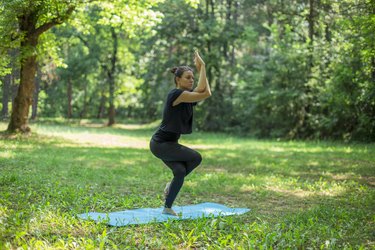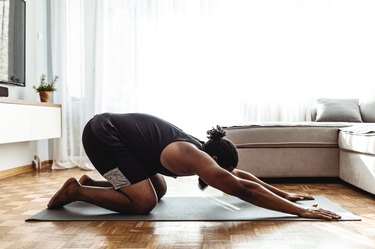
If you're looking to level up your yoga practice, adding in eagle pose — a single-leg balancing posture — can help you get there.
Translated from the Sanskrit word Garudasana — "garu" means "eagle" or "a fierce bird of prey" and "asana" means "pose" — it's an appropriate name for this challenging and fiery standing yoga pose. But while this pose may look like a jumble of twisted limbs, there are ways to make it easier and still reap its benefits.
Video of the Day
Read on to learn more about eagle pose, how to do it, why you should do it, form tips and modifications.
- What is eagle pose? It's a yoga pose classified as an asymmetrical standing balancing pose. This dynamic pose has many layers, beginning with balancing on one leg with one knee bent and the opposite leg wrapped over and around the standing leg to create a compressive twist in your lower body. As you hold your legs in this position, your arms are similarly intertwined or wrapped around one another, but with the opposite arm on top to balance out both sides of your body.
- What is eagle pose good for? This yoga pose helps you improve your balance. It also stretches your shoulders, upper back, thighs and hips and strengthens your core, thighs, hips, legs and ankles.
- Who can do eagle pose? If balancing on one leg doesn't feel safe or attainable to you, eagle pose might not fit well into your practice. However, if you're working toward a goal of better balance and feel capable of one day doing a variation of eagle pose, use a wall for support to start. If you experience pain in the pose, play it safe and exit immediately.
- How long should you hold eagle pose? Hold eagle pose for as long as you can! Realistically, though, your lower body can feel fatigued in this position after a short period of time, so a great length of time to start with is to count three rounds of breath and work up to five rounds of breath (about 1 minute). As always, it's up to you to listen to your body and decide when to exit a pose.
How to Do Eagle Pose With Proper Form
- On your yoga mat, begin in mountain pose (Tadasana), a standing position, with your feet hip-width distance apart.
- Bend your knees and sink your hips back as if you were sitting in a chair.
- Cross your right leg over your left leg and, if you're able, hook your right ankle behind your left shin. You can also place the toes of your right foot down on the mat without trying to wrap it around your left shin if that's more comfortable for your body.
- Sit deeply and squeeze your legs together for stability.
- Swing your arms out in front of you and cross your left arm over your right arm. Wrap your arms around one another so that your palms touch together. Elevate your elbows away from the mat to stretch the back of your heart.
- As you exhale, hug your arms and legs towards the midline of your body and sit deeply into the pose. Inhale to elongate your spine and breathe into the back of your lungs.
- Hold here for three to five breaths, then switch sides.
- For more of a challenge, sit as low as possible and hold for 1 minute or more.
Tip
The unique design of your bony structure, joints and flexibility may make it easier or harder to create the double wrap of their arms and legs, and it’s important to note that not everyone will be able to create that double wrap. This is completely OK!
You can still practice a single wrap of your lower and upper body to create the compressive twist and get the pose's same benefits (more on this variation below). Don’t let what seems like a limitation prevent you from feeling grateful and proud of the shape you can make on your mat!
Eagle Pose Benefits
When done well, eagle pose can improve your balance over time. Like all other balancing poses, holding this physically demanding posture and remaining connected to your breath can increase your stamina and focus.
Eagle pose is also surprisingly great for your nervous system, according to Lindsay Mayock, DPT, E-RYT 500, a physical therapist and experienced registered yoga teacher.
"Anytime we're using just one of our legs as a base of support, we're challenging all of our balancing centers within each joint of the standing leg — and those are the proprioceptive aspects [the ability to sense where your body is at all times] of the nervous system," Mayock tells LIVESTRONG.com. "When you remove a point of contact and rely on one base of support, you'll feel a lot of calibration in your foot, ankle, and all the way up your leg. That's one of the main ways balance is improved in any single-standing pose. It's really through the nervous system."
Eagle pose can also stretch your shoulders, upper back, thighs and hips and strengthen your core, thighs, hips, legs and ankles.
"Beyond balance, we are generating a ton of stabilization strength [in this pose]," Mayock says.
Common Mistakes in Eagle Pose (and How to Fix Them)
Because eagle pose requires one leg to bear most of your body weight, it's common for the hip on your standing leg to swing out to the side due to muscle weakness, which isn't an optimal position for all of that load.
Correct that misalignment by hugging your outer hip in toward the midline of your body and reach your hips back as if you were going to sit down. This will create more strength and stability in your hip muscles, elongate your spine to avoid lower back issues and hopefully eliminate any pain or discomfort down the road.
Eagle Pose Modifications
1. Eagle Pose With Foot on Floor
- On your yoga mat, begin in mountain pose (Tadasana), a standing position, with your feet hip-width distance apart.
- Bend your knees and sink your hips back as if you were sitting in a chair.
- Cross your right leg over your left leg and place the toes of your right foot down on the mat without trying to wrap it around your left shin.
- Sit deeply and squeeze your legs together.
- Swing your arms out in front of you and cross your left arm over your right arm. Wrap your arms around one another so that your palms touch together. Elevate your elbows away from the mat to stretch the back of your heart.
- As you exhale, hug your arms and legs toward the midline of your body and sit deeply into the pose. Inhale to elongate in your spine and breathe into the back of your lungs.
- Hold here for three to five breaths, then switch sides.
2. Eagle Pose Hugging Your Shoulders
- On your yoga mat, begin in mountain pose (Tadasana), a standing position, with your feet hip-width distance apart.
- Bend your knees and sink your hips back as if you were sitting in a chair.
- Cross your right leg over your left leg and, if you're able, hook your right ankle behind your left shin. You can also place the toes of your right foot down on the mat without trying to wrap it around your left shin if that's more comfortable for your body.
- Sit deeply and squeeze your legs together for stability.
- Swing your arms out in front of you and cross the left arm over the right. Grab hold of opposite shoulders so the left elbow stacks overtop the right. Squeeze the arms together and elevate the elbows away from the mat to stretch the back of the heart.
- Hold here for three to five breaths and switch sides.
Tip
This modification is great for people who have tight shoulders and are unable to do a single or double wrap with their arms.
How to Add Eagle Pose to Your Yoga Practice
Incorporate eagle pose into your yoga practice after you've warmed up with a few rounds of sun salutations and standing poses like warrior I (Virabhadrasana I) or warrior II (Virabhadrasana II). It's a great pose to do in conjunction with other standing balancing poses like tree pose (Vrksasana) or before a deeper and more challenging twist, like revolved triangle pose (Parivrtta Trikonasana).




